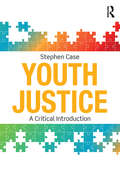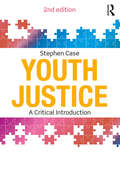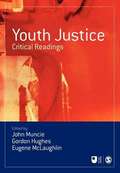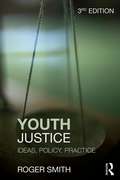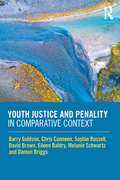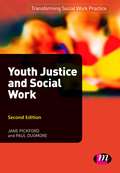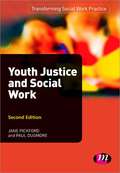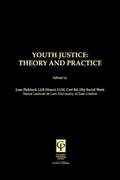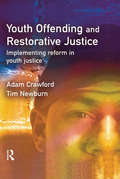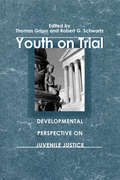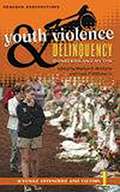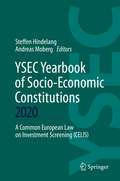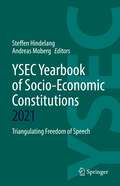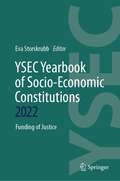- Table View
- List View
Youth Justice: A Critical Introduction
by Stephen CaseThis book provides a comprehensive, student-friendly and critical introduction to youth justice in England and Wales, offering a balanced evaluation of its development, rationale, nature and evidence base. It explores the evolution of definitions and explanations of youth offending and examines the responses to it that constitute youth justice. Bringing together theory and practice, this book provides a balanced exposition of contemporary youth justice debates, including detailed discussions of governmental rationales and practical issues and an extensive evaluation of critical academic positions. It includes a range of features designed to engage and inspire students: ‘Stop and think’: Activities challenging students to reflect on important issues. ‘Conversations’: Discussions of key themes and issues from the perspectives and experiences of relevant stakeholders, including policy makers and activists. ‘Telling it like it is’: Testimonies giving voice to the personalised, subjective and contentious viewpoints of youth justice influencers. ‘Controversies and debates’: Prompts to stimulate students to question and critique established knowledge and understanding by considering alternative angles. ‘Recurring theme alerts’: Boxes flagging up recurring themes in the developing construction of youth offending and youth justice. This book is essential reading for students taking courses in youth justice, youth offending, youth crime, youth work and social policy.
Youth Justice: A Critical Introduction
by Stephen CaseThis book provides a comprehensive, student-friendly and critical introduction to youth justice in England and Wales, offering a balanced evaluation of its development, rationale, nature and evidence base. It explores the evolution of definitions and explanations of youth offending and examines the responses to it that constitute youth justice. Bringing together theory and practice, this book provides a balanced exposition of contemporary youth justice debates, including detailed discussions of governmental rationales and practical issues and an extensive evaluation of critical academic positions. It includes a range of features designed to engage and inspire students: ‘Stop and think’: Activities challenging students to reflect on important issues. ‘Conversations’: Discussions of key themes and issues from the perspectives and experiences of relevant stakeholders, including policy makers and activists. ‘Telling it like it is’: Testimonies giving voice to the personalised, subjective and contentious viewpoints of youth justice influencers. ‘Controversies and debates’: Prompts to stimulate students to question and critique established knowledge and understanding by considering alternative angles. ‘Recurring theme alerts’: Boxes flagging up recurring themes in the developing construction of youth offending and youth justice. This book is essential reading for students taking courses in youth justice, youth offending, youth crime, youth work and social policy.
Youth Justice: A Critical Introduction
by Stephen CaseThis book provides a comprehensive, student-friendly and critical introduction to youth justice in England and Wales, offering a balanced evaluation of its development, rationale, nature and evidence base. It explores the evolution of definitions and explanations of youth offending and examines the responses to it that constitute youth justice. Bringing together theory, policy and practice, this book provides a balanced exposition of contemporary youth justice debates, including detailed discussions of governmental rationales, policy developments, practical issues and an extensive evaluation of critical academic positions. It includes a range of features designed to engage and inspire students: ‘Stop and think’: Activities challenging students to reflect on important issues. ‘Conversations’: Discussions of key themes and issues from the perspectives and experiences of relevant stakeholders, including policy makers and activists. ‘Telling it like it is’: Testimonies giving voice to the personalised, subjective and contentious viewpoints of youth justice influencers. ‘Controversies and debates’: Prompts to stimulate students to question and critique established knowledge and understanding by considering alternative angles. ‘Recurring theme alerts’: Boxes flagging recurring themes in the developing construction of youth offending and youth justice. The new edition has been fully revised and updated and includes discussion of revised National Standards in Youth Justice, the new ‘Child First’ strategic objective for youth justice, the ‘trauma informed practice’ movement, the impact of coronavirus on children in the Youth Justice System and the continued impact of austerity on policy and practice. This book is essential reading for students taking courses in youth justice, youth offending, youth crime, youth work and social policy.
Youth Justice: A Critical Introduction
by Stephen CaseThis book provides a comprehensive, student-friendly and critical introduction to youth justice in England and Wales, offering a balanced evaluation of its development, rationale, nature and evidence base. It explores the evolution of definitions and explanations of youth offending and examines the responses to it that constitute youth justice. Bringing together theory, policy and practice, this book provides a balanced exposition of contemporary youth justice debates, including detailed discussions of governmental rationales, policy developments, practical issues and an extensive evaluation of critical academic positions. It includes a range of features designed to engage and inspire students: ‘Stop and think’: Activities challenging students to reflect on important issues. ‘Conversations’: Discussions of key themes and issues from the perspectives and experiences of relevant stakeholders, including policy makers and activists. ‘Telling it like it is’: Testimonies giving voice to the personalised, subjective and contentious viewpoints of youth justice influencers. ‘Controversies and debates’: Prompts to stimulate students to question and critique established knowledge and understanding by considering alternative angles. ‘Recurring theme alerts’: Boxes flagging recurring themes in the developing construction of youth offending and youth justice. The new edition has been fully revised and updated and includes discussion of revised National Standards in Youth Justice, the new ‘Child First’ strategic objective for youth justice, the ‘trauma informed practice’ movement, the impact of coronavirus on children in the Youth Justice System and the continued impact of austerity on policy and practice. This book is essential reading for students taking courses in youth justice, youth offending, youth crime, youth work and social policy.
Youth Justice: Critical Readings (PDF)
by John Muncie Gordon Hughes Eugene Mclaughlin`An excellent reader. It contains all the basic ingredients of a superb teaching book with the qualities of a thought-provoking text. . . . Should be required reading for all students of criminal justice policy and it will be a valuable teaching resource for all those involved in the delivery of courses on young people, justice and punishment' - Punishment and Society `This is a valuable student text; carefully collated and with an abuntant array of material. . . and will surely become a widely used course reader. For the practitioner and general reader it is a book to dip into, a means to access debates and remind oneself of the ebb and flow of policy' - Youth Justice Youth Justice brings together for the first time the most influential international contributors to the emergent field of youth justice studies. Youth Justice provides: #65533; a critical introduction to the intellectual reframing of the history, theory, policy and practice of youth justice. #65533; an essential resource of key debates and controversies from across the range of disciplines engaged in the study of youth in the social sciences #65533; editorial essays at the beginning of each substantive section of the volume #65533; specially commissioned chapters at the end of each section, which place the readings in their theoretical and historical context. The Reader is the set text for The Open University course, Youth Justice, Penality and Social Control (D864).
Youth Justice: Ideas, Policy, Practice
by Roger S. SmithThe exciting new edition of this well-loved textbook offers a fully expanded and revised account and analysis of the youth justice system in the UK, taking into account and fully addressing the significant changes that have taken place since the second edition in 2007. The book maintains its critical analysis of the underlying assumptions and ideas behind youth justice, as well as its policy and practice, laying bare the inadequacies, inconsistencies and injustices of practice in the UK. This edition will offer an important update in light of intervening changes, as reflected in a change of government and shifting patterns of interventions and outcomes. This book will be an important resource for youth justice practitioners and will also be essential to students taking courses in youth crime and youth justice.
Youth Justice and Child Protection
by Andrew Lockyer Fred Stone Malcolm HillThis book is an examination of recent developments in the areas of youth justice and child protection. It investigates how well young people and the societies in which they live are served by judicial and service systems. Consideration is given to those in care - in young offenders' institutions, foster families and residential homes - as well as those living with their families. A broad range of international experts discuss the largely segregated youth justice and children's legal and service systems in England and Wales, other parts of Western Europe and the US, and compare these with Scotland's integrated system. The implications of these arrangements are considered for the rights of children and parents on the one hand and society on the other. The contributors also provide insights into the rationale for current and proposed policies, as well as the efficacy of different systems. This book will be an important reference for policy-makers, social workers, lawyers, magistrates and equivalent decision makers, health professionals, carers, and all those working in youth justice and child protection. It is highly relevant for academics and students interested in children, citizenship, youth crime, child welfare and state-family relations.
Youth Justice and Child Protection (PDF)
by Andrew Lockyer Fred Stone Malcolm HillThis book is an examination of recent developments in the areas of youth justice and child protection. It investigates how well young people and the societies in which they live are served by judicial and service systems. Consideration is given to those in care - in young offenders' institutions, foster families and residential homes - as well as those living with their families. A broad range of international experts discuss the largely segregated youth justice and children's legal and service systems in England and Wales, other parts of Western Europe and the US, and compare these with Scotland's integrated system. The implications of these arrangements are considered for the rights of children and parents on the one hand and society on the other. The contributors also provide insights into the rationale for current and proposed policies, as well as the efficacy of different systems. This book will be an important reference for policy-makers, social workers, lawyers, magistrates and equivalent decision makers, health professionals, carers, and all those working in youth justice and child protection. It is highly relevant for academics and students interested in children, citizenship, youth crime, child welfare and state-family relations.
Youth Justice and Penality in Comparative Context
by Barry Goldson Chris Cunneen Sophie Russell David Brown Eileen Baldry Melanie Schwartz Damon BriggsThis book represents the first major analysis of Anglo-Australian youth justice and penality to be published and it makes significant theoretical and empirical contributions to the wider field of comparative criminology. By exploring trends in law, policy and practice over a forty-year period, the book critically surveys the ‘moving images’ of youth justice regimes and penal cultures, the principal drivers of reform, the core outcomes of such processes and the overall implications for theory building. It addresses a wide range of questions including: How has the temporal and spatial patterning of youth justice and penality evolved since the early 1980s to the present time? What impacts have legislative and policy reforms imposed upon processes of criminalisation, sentencing practices and the use of penal detention for children and young people? How do we comprehend both the diverse ways in which public representations of ‘young offenders’ are shaped, structured and disseminated and the varied, conflicting and contradictory effects of such representations? To what extent do international human rights standards influence law, policy and practice in the realms of youth justice and penality? To what extent are youth justice systems implicated in the production and reproduction of social injustices? How, and to what degree, are youth justice systems and penal cultures internationalised, nationalised, regionalised or localised? The book is essential reading for researchers, students and tutors in criminology, criminal justice, law, social policy, sociology and youth studies.
Youth Justice and Penality in Comparative Context
by Barry Goldson Chris Cunneen Sophie Russell David Brown Eileen Baldry Melanie Schwartz Damon BriggsThis book represents the first major analysis of Anglo-Australian youth justice and penality to be published and it makes significant theoretical and empirical contributions to the wider field of comparative criminology. By exploring trends in law, policy and practice over a forty-year period, the book critically surveys the ‘moving images’ of youth justice regimes and penal cultures, the principal drivers of reform, the core outcomes of such processes and the overall implications for theory building. It addresses a wide range of questions including: How has the temporal and spatial patterning of youth justice and penality evolved since the early 1980s to the present time? What impacts have legislative and policy reforms imposed upon processes of criminalisation, sentencing practices and the use of penal detention for children and young people? How do we comprehend both the diverse ways in which public representations of ‘young offenders’ are shaped, structured and disseminated and the varied, conflicting and contradictory effects of such representations? To what extent do international human rights standards influence law, policy and practice in the realms of youth justice and penality? To what extent are youth justice systems implicated in the production and reproduction of social injustices? How, and to what degree, are youth justice systems and penal cultures internationalised, nationalised, regionalised or localised? The book is essential reading for researchers, students and tutors in criminology, criminal justice, law, social policy, sociology and youth studies.
Youth Justice and Social Work
by Paul Dugmore Jane PickfordIt is vital for social work students and practitioners to understand the complexities of the youth justice system. This fully revised second edition analyses and puts into context several pieces of new legislation such as the Criminal Justice and Immigration Act 2008, the Youth Rehabilitation Order 2009 and the new Youth Conditional Caution. Carefully selected case studies and summaries of contemporary research help to underpin this accessible and essential resource. Ideal for students on placement, this new edition enables the reader to follow complex and often difficult legislation and law.
Youth Justice and Social Work (PDF)
by Paul Dugmore Jane PickfordIt is vital for social work students and practitioners to understand the complexities of the youth justice system. This fully revised second edition analyses and puts into context several pieces of new legislation such as the Criminal Justice and Immigration Act 2008, the Youth Rehabilitation Order 2009 and the new Youth Conditional Caution. Carefully selected case studies and summaries of contemporary research help to underpin this accessible and essential resource. Ideal for students on placement, this new edition enables the reader to follow complex and often difficult legislation and law. Alternate ISBNs 9780857253217
Youth Justice: Theory & Practice
by Jane PickfordThis innovative text examines contemporary issues in youth justice in the light of the sweeping reforms introduced by the Crime and Disorder Act 1998 and the Youth Justice and Criminal Evidence Bill 1999. It brings together current debates in both the practice and theory of youth justice intervention and, in the light of the governments inter-agency approach to the problem of youth criminality, provides an inter-disciplinary examination of these discussions. Including contributions from both academics, magistrates and social work practitioners, it is a useful text for students of criminology, law and social work, as well as a valuable resource for youth justice practitioners.
Youth Justice: Theory & Practice
by Jane PickfordThis innovative text examines contemporary issues in youth justice in the light of the sweeping reforms introduced by the Crime and Disorder Act 1998 and the Youth Justice and Criminal Evidence Bill 1999. It brings together current debates in both the practice and theory of youth justice intervention and, in the light of the governments inter-agency approach to the problem of youth criminality, provides an inter-disciplinary examination of these discussions. Including contributions from both academics, magistrates and social work practitioners, it is a useful text for students of criminology, law and social work, as well as a valuable resource for youth justice practitioners.
Youth Offending and Restorative Justice: Implementing Reform In Youth Justice
by Tim Newburn Adam CrawfordThis book provides an empirically grounded, theoretically informed account of recent changes to the youth justice system in England and Wales, focusing on the introduction of elements of restorative justice into the heart of the criminal justice system, and the implementation of referral orders and youth offender panels. Taken together, this amounts to the most radical overhaul of the youth justice system in the last half century, fundamentally changing the underlying values of the system away from an 'exclusionary punitive justice' and towards an 'inclusionary restorative justice'. The book explores the implications of these changes by using the lens of a detailed study of the implementation of referral orders and youth offender panels to explore wider issues about youth justice policy and the integration of restorative justice principles. It draws upon the findings of an in-depth study of the pilots established prior to the national rollout of referral orders in April 2002. The book will be essential reading not only for those involved in the task of implementing the new youth justice, but others with an interest in the criminal justice system and in restorative justice who need to know about the far reaching reforms to the youth justice system and their impact.
Youth on Trial: A Developmental Perspective on Juvenile Justice (The John D. and Catherine T. MacArthur Foundation Series on Mental Health and Development, Research Network on Adolescent Development and Juvenile Justice)
by Thomas Grisso Robert G. SchwartzIt is often said that a teen "old enough to do the crime is old enough to do the time," but are teens really mature and capable enough to participate fully and fairly in adult criminal court? In this book—the fruit of the MacArthur Foundation Network on Adolescent Development and Juvenile Justice—a wide range of leaders in developmental psychology and law combine their expertise to investigate the current limitations of our youth policy. The first part of the book establishes a developmental perspective on juvenile justice; the second and third parts then apply this perspective to issues of adolescents' capacities as trial defendants and questions of legal culpability. Underlying the entire work is the assumption that an enlightened juvenile justice system cannot ignore the developmental psychological realities of adolescence. Not only a state-of-the-art assessment of the conceptual and empirical issues in the forensic assessment of youth, Youth on Trial is also a call to reintroduce sound, humane public policy into our justice system.. Contributors: Richard Barnum, Richard J. Bonnie, Emily Buss, Elizabeth Cauffman, Gary L. Crippen, Jeffrey Fagan, Barry C. Feld, Sandra Graham, Thomas Grisso, Colleen Halliday, Alan E. Kazdin, N. Dickon Reppucci, Robert G. Schwartz, Elizabeth Scott, Laurence Steinberg, Ann Tobey, Jennifer L. Woolard, Franklin E. Zimring
The Youth Unemployment Crisis: A Reference Handbook (Contemporary World Issues)
by Christina G. VillegasSurveys the history of youth unemployment and identifies key issues underlying the current crisis.The Youth Unemployment Crisis: A Reference Handbook examines the recent phenomenon in the United States wherein young workers ages 16 to 24 are unemployed or disconnected from the labor force at disproportionate rates. It describes in detail what led to the crisis, who it affects, and what can be and is being done about it. The book opens with a chapter that addresses the nature and scope of the crisis, which is followed by a discussion of the inherent problems, controversies, and possible solutions. It includes essays from a diverse range of contributors, providing useful perspectives to round out the author's expertise, as well as a collection of data and documents; an overview of important people, organizations, and resources relating to the crisis; a chronology listing important events in the youth unemployment timeline; and a glossary of key terms.
The Youth Unemployment Crisis: A Reference Handbook (Contemporary World Issues)
by Christina G. VillegasSurveys the history of youth unemployment and identifies key issues underlying the current crisis.The Youth Unemployment Crisis: A Reference Handbook examines the recent phenomenon in the United States wherein young workers ages 16 to 24 are unemployed or disconnected from the labor force at disproportionate rates. It describes in detail what led to the crisis, who it affects, and what can be and is being done about it. The book opens with a chapter that addresses the nature and scope of the crisis, which is followed by a discussion of the inherent problems, controversies, and possible solutions. It includes essays from a diverse range of contributors, providing useful perspectives to round out the author's expertise, as well as a collection of data and documents; an overview of important people, organizations, and resources relating to the crisis; a chronology listing important events in the youth unemployment timeline; and a glossary of key terms.
Youth Violence and Delinquency [3 volumes]: Monsters and Myths [3 volumes] (Criminal Justice, Delinquency, and Corrections)
by Marilyn D. McShane Franklin P. WilliamsJuvenile crime and violence has always piqued the public's interest. Indeed, each generation of Americans tends to define the youth crime problem as more serious than any previous generation. Even though juvenile homicides have been decreasing since the mid-1990s, the media is still quick to provide dramatic examples of juvenile monsters who are terrorizing their communities. Shootings at school, gang banging and trafficking drugs, school bullies, and charging juveniles as adults are subjects that have recently received wide media coverage. This three volume set on the nature, incidence, consequences, and treatment of youth crime and violence will help readers understand the true nature of youth crime and violence from a variety of perspectives. Each volume covers a different area and experts write on topics ranging from sex offending to fire starting, from gangs to guns, from juvenile probation to charging youths as adults, from mandatory mental health treatment to police in school settings, and more.What drives a teenager to steal? To kill? Why does youth crime and violence occur? Why are youths such vulnerable targets? What can be done to stop youth offenders, and what can be done to help youthful victims? How does the criminal justice system respond? What do communities do to punish and protect youths? What can schools do to intervene? All these questions and more are answered in this set on this timely and important topic. Our youth are our most precious commodity, and protecting vulnerable children as well as helping offenders is of paramount importance for steering them toward safe and productive lives. These volumes help readers better understand the causes and consequences of youth violence and crime and consider ways to address the problems.
YSEC Yearbook of Socio-Economic Constitutions 2020: A Common European Law on Investment Screening (CELIS) (YSEC Yearbook of Socio-Economic Constitutions #2020)
by Steffen Hindelang Andreas MobergThis book presents the very first, interdisciplinarily grounded, comprehensive appraisal of a future “Common European Law on Investment Screening”. Thereby, it provides a foundation for a European administrative law framework for investment screening by setting out viable solutions and evaluating their pros and cons. Daimler, the harbour terminal in Zeebrugge, or Saxo Bank are only three recent examples of controversially discussed company takeovers in Europe. The “elephant in the room” is China and its “Belt and Road Initiative”. The political will in Europe is growing to more actively control investments flowing into the EU. The current regulatory initiatives raise several fundamental, constitutional and regulatory issues. Surprisingly, they have not been addressed in any depth so far. The book takes stock of the current rather fragmented regulatory approaches and combines contributions from leading international academics, practitioners, and policy makers in their respective fields. Due to the volume’s comprehensive approach, it is expected to influence the broader debate on the EU’s upcoming regulation of this matter. The book is addressed to participants from academia as well as to representatives from government, business, and civil society.
YSEC Yearbook of Socio-Economic Constitutions 2021: Triangulating Freedom of Speech (YSEC Yearbook of Socio-Economic Constitutions #2021)
by Steffen Hindelang Andreas MobergThis volume addresses contemporary challenges, enabled by modern technology, that concern upholding freedom of speech where it conflicts with social rights, such as respect for private and family life, and with economic rights, such as the freedom to conduct business or the right to free movement. In today’s networked world, technological shifts happen faster than most people even realize. Some of these shifts have made us all potentially powerful: media powerful. We used to sit in silence in front of newspapers and TV screens, and the world was explained to us by just a few sources. Today, thanks to the Internet, social media, and Web 2.0, we can not only share our own thoughts with everyone in a more self-determined way, but we can also take part in public debate and even co-shape it ourselves. Of course, the Internet is not a counter-design to the communication (power) structures of the past. Gains in communicative self-determination are threatened due to algorithmisation, platformisation, and value extraction from self-created private markets. At the same time, the empowerment of the individual challenges the old “grand speakers” who are suddenly detecting “fake news”, echo chambers, and filter bubbles everywhere on the Internet. Internet-based communication allegedly hinders us from the “one truth”; as if newspaper hoaxes, propaganda, and narrow-mindedness were an invention of the Internet. The current heated debate over “fake news”, copyright, and “upload filters” shows that we are unsure of how to deal with the newer and more complex phenomena of Internet-based speech. This is due in no small part to the fact that an important benchmark – our constitutional compass – is still firmly rooted in the past. Constitutions change far more slowly than technologies. Societal changes can drive constitutional changes; but what about normative content control? Today, there are already demands for “old-school clarity”: truth filters on social media platforms, horrendous sums of liability for platforms that encourage (overly)thorough cleaning up. However, it is equally true that private individuals “regulate”: they decide what is found on the Internet and who may post on a given platform. Accounting for all interests at play and striking a “fair” balance that avoids both a public and private over- and under-regulation is a complex matter. The authors of this volume not only provide reflections in their highly topical contributions, but also share their understanding of what constitutes a fair balance within the larger frame of freedom of speech in a digital age.
YSEC Yearbook of Socio-Economic Constitutions 2022: Funding of Justice (YSEC Yearbook of Socio-Economic Constitutions #2022)
by Eva StorskrubbFunding of justice has significant consequences for the enforcement of rights and impacts directly on access to justice and the right to a fair trial as constitutional rights. Access to justice in turn essentially impacts on the effective enjoyment of any other constitutional right, since having the actual means to access a court in case of a potential breach strengthens that right. Public funding, such as legal aid, has come under pressure due to the reality of financial austerity measures and the tightening public budgets in many countries. This has contributed to privatization and marketisation of funding in ever more jurisdictions. Private forms of funding include inter alia litigation insurance, third-party litigation finance and crowdfunding, as well as different forms of assigning or selling claims. As public funding is in decline and as market liberalization in the field of justice increases, crucial questions related to the rule of law, access to justice and social and economic development, in the intersection between states, citizens and business are raised. For example, potential questions of conflict of interest and how to ensure a basic level of equality of access to funding, whilst at the same time protecting market freedom. Some of the contributions in the volume deal with the consequences of privatization of funding of justice on access to justice from a general, principled and theoretical perspective. Other contributions deal with specific regulatory developments or issues at the EU level, alternatively at the local level in specific jurisdictions. Further contributions deal with crucial issues of funding of justice in environmental matters, that are increasingly relevant and topical in practice.
Zahnarztrecht: Praxishandbuch für Zahnmediziner
by Hans-Peter Ries Karl-Heinz Schnieder Jürgen Althaus Ralf Großbölting Martin VoßJeder Zahnarzt ist einer Fülle von häufig wechselnden rechtlichen Regelungen unterworfen, deren Folgen im Konfliktfall schnell und präzise eingeschätzt werden müssen. Ein Team anerkannter Experten, unter ihnen drei Fachanwälte für Medizinrecht, stellt die komplizierte Materie übersichtlich und verständlich dar. Das Praxishandbuch bietet eine rasche Orientierung bei der Klärung zahnärztlicher Rechtsfragen aus allen relevanten Bereichen. Checklisten, Entscheidungshilfen und Verteidigungsstrategien unterstützen die sofortige Umsetzbarkeit.
Zeit und Recht: Kritische Anmerkungen zur Zeitgebundenheit des Rechts und des Rechtsdenkens (Forschungen aus Staat und Recht #100)
by Günther WinklerAls ich mich in den fiinfZiger Jahren anschickte, eine Habilitations schrift zu erarbeiten, war ich vom Thema der Rechtskraft fasziniert. Stu dien zum formgebundenen Verwaltungsakt (Bescheid) fuhrten mich zur Erkundung seiner zeitlichen Entstehungsvoraussetzungen. Unter den we sentlichen Elementen (Merkmalen) des formgebundenen Verwaltungsak tes (Bescheides) nahmen zunachst seine Erlassung und sein Inkrafttreten, zwei unterschiedlich zeitgebundene Voraussetzungen fur seine Rechtser heblichkeit und fur seine Rechtsverbindlichkeit, me in ganzes Interesse in Anspruch. Alsbald schrankte ich jedoch meine Nachforschungen auf die wesentlichen Bedingungen der Rechtserheblichkeit, der rechtlichen Exi stenz eines Staatsakres ein. Die Untersuchung der formell-rechtlichen und der materiell-rechtlichen Verbindlichkeit, im weitesten Sinn als Rechts kraft verstanden, verschob ich auf spater. Die rechtliche Zeitform der Frist und die Zeitlichkeit der Bedingung im rechtsgeschaftlichen Handeln hatten durch das Studium des Romi schen Rechts schon Jahre vorher mein besonderes Interesse geweckt. 1m Zusammenhang mit Fragen nach dem Inkrafttreten und nach dem AuBer krafttreten von Gesetzen offnete mir spater meine Befassung mit dem Ver waltungsrecht und mit dem Verfassungsrecht den Blick auf die entschei dende Bedeutung der Zeit fur die Geltung, fur die Verbindlichkeit und fur die Wirksamkeit des Gesetzesrechts. Durch Einzelstudien uber Gel tung und Verbindlichkeit von Staatsvertragen wurde mir das Verhaltnis von Zeit und Recht alsbald zu einer Frage, die sich fur mein Rechtsden ken anhaltend als grundlegend erwies. Die allgemeine Frage nach dem Verhaltnis von Zeit und Recht ruckte zusehends in den Vordergrund mei nes theoretischen Interesses.
Zeitmanagement für Juristen: Weniger Stress - mehr Effizienz - mehr freie Zeit
by Jochen TheurerDieses Buch stellt Zeitmanagement-Strategien speziell für Juristen und Rechtsanwälte, Steuerberater und Wirtschaftsprüfer vor. Diese Berufsgruppen, die Standesregeln oder hohem wirtschaftlichen Druck ausgesetzt sind, klagen häufig über Zeitprobleme. Doch die üblichen Ratschläge zum Thema Zeitmanagement helfen ihnen aufgrund der besonderen beruflichen Anforderungen meist nicht weiter. Zudem sind die Zeitprobleme so individuell, dass eine „allgemeine“ Strategie nicht passt. Hier setzt dieses Buch an: Es vermittelt Juristen und Rechtsanwälten, Steuerberatern und Wirtschaftsprüfern das Wissen und erläutert die Werkzeuge, um selbständig Strategien für ihre persönlichen Zeitprobleme zu entwickeln und diese erfolgreich in ihrem beruflichen Alltag umzusetzen.
